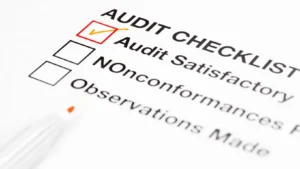The Importance of Website Audits: Enhancing Your Online Presence

Introduction
In today’s digital age, a high-performing website is paramount for businesses of all sizes. It serves as the virtual storefront, the first point of contact for potential customers, and the hub of online operations. A well-maintained website not only attracts visitors but also keeps them engaged, converts them into customers, and fosters brand loyalty.
Website audits play a pivotal role in ensuring that a website operates at its peak performance level. They involve a comprehensive analysis of various aspects of a website, including design, content, functionality, and SEO. By identifying areas for improvement and addressing underlying issues, website audits help businesses enhance user experience, increase visibility on search engines, and ultimately achieve their online goals.
Key Points
-
Significance of Website Performance
A high-performing website is essential for attracting and retaining customers, driving conversions, and maintaining a competitive edge in the digital landscape.
-
Role of Website Audits
Website audits are strategic assessments that evaluate the effectiveness and efficiency of a website’s design, functionality, and content. They provide valuable insights into areas for improvement and opportunities for optimization.
-
Optimizing Online Presence
Through website audits, businesses can identify and address issues related to user experience, SEO, security, and performance, thereby maximizing their online presence and driving business growth.
By recognizing the importance of maintaining a high-performing website and understanding the role of website audits in achieving this goal, businesses can stay ahead of the curve and deliver exceptional online experiences to their audience.
Why Website Audits are Necessary

Identifying Weaknesses and Opportunities
1. Pinpointing Areas for Improvement
Analyze website performance metrics such as loading speed, bounce rate, and user engagement to identify weaknesses
Loading Speed: Slow loading times can lead to higher bounce rates and decreased user satisfaction. By assessing loading speed, businesses can identify performance bottlenecks and take steps to optimize website speed.
Bounce Rate: A high bounce rate indicates that visitors are leaving the site without interacting further. Website audits help pinpoint the pages with the highest bounce rates, allowing businesses to improve content, navigation, and overall user experience.
User Engagement: Analyzing user engagement metrics such as time on page, scroll depth, and click-through rates provides insights into how visitors interact with the website. By understanding user behavior, businesses can tailor content and design elements to better meet the needs and preferences of their audience.
Identify opportunities for enhancement, such as optimizing conversion paths and improving user experience
Conversion Paths: Website audits assess the effectiveness of conversion paths, such as signup forms, checkout processes, and contact forms. By optimizing these paths, businesses can streamline the user journey and increase conversion rates.
User Experience: Evaluate website usability and accessibility to ensure a seamless and intuitive browsing experience for visitors. Addressing issues such as broken links, navigation errors, and mobile responsiveness enhances user satisfaction and encourages repeat visits.
Website audits and pinpointing areas for improvement, businesses can optimize their online presence, enhance user experience, and achieve their digital marketing objectives.
-
Ensuring Compliance and Security:

Maintaining Compliance Standards
Ensure adherence to regulatory requirements such as GDPR and ADA accessibility standards:
GDPR Compliance: Website audits assess data collection and processing practices to ensure compliance with the General Data Protection Regulation (GDPR). Businesses must obtain explicit consent for data collection, provide transparency regarding data usage, and implement measures to secure personal data.
ADA Accessibility: Evaluate website accessibility to ensure compliance with the Americans with Disabilities Act (ADA). This includes providing alternative text for images, ensuring keyboard navigation, and optimizing content for screen readers. By making websites accessible to all users, businesses demonstrate inclusivity and avoid potential legal issues.
Assess website security measures to prevent vulnerabilities and data breaches:
Security Vulnerabilities: Website audits identify potential security vulnerabilities, such as outdated software, weak passwords, and inadequate encryption protocols. By addressing these vulnerabilities promptly, businesses can mitigate the risk of cyberattacks and protect sensitive data.
Data Breach Prevention: Implement security measures such as SSL encryption, firewalls, and regular security updates to safeguard against data breaches. Conducting regular website audits helps identify and address security gaps before they can be exploited by malicious actors.
Ensuring compliance with regulatory standards and implementing robust security measures is essential for safeguarding customer data, protecting business reputation, and maintaining trust with stakeholders. By prioritizing compliance and security in website audits, businesses demonstrate their commitment to ethical business practices and customer privacy.
-
Enhancing Search Engine Visibility
Improving Search Engine Rankings
Evaluate on-page SEO elements such as meta tags, headings, and keyword usage:
Meta Tags: Review meta title tags, meta descriptions, and meta keywords to ensure they accurately reflect the content of each webpage and incorporate relevant keywords. Optimizing meta tags improves search engine visibility and click-through rates.
Headings: Assess the hierarchy and structure of headings (H1, H2, H3, etc.) to ensure they are properly formatted and contain relevant keywords. Clear and concise headings help search engines understand the content and context of each webpage.
Keyword Usage: Analyze keyword density and placement within page content, headings, and image alt attributes. Incorporating target keywords naturally and strategically throughout the website helps improve relevance and ranking for relevant search queries.
Analyze off-page SEO factors including backlink quality and domain authority
Backlink Quality: Evaluate the quality and relevance of inbound links pointing to the website from external sources. High-quality backlinks from authoritative websites signal credibility and authority to search engines, positively impacting search engine rankings.
Domain Authority: Assess the overall authority and credibility of the website’s domain based on factors such as age, popularity, and backlink profile. Improving domain authority through reputable backlinks and high-quality content enhances search engine visibility and trustworthiness.
Enhancing search engine visibility is essential for driving organic traffic, increasing brand exposure, and maximizing online visibility. By optimizing on-page and off-page SEO elements, businesses can improve search engine rankings and attract qualified leads to their website.
Why Website Audits are Worth It
-
Maximizing ROI and Conversions:
Increasing Conversion Rates
Optimize website elements to improve conversion rates and maximize return on investment:
- Conduct A/B testing to compare different variations of website elements such as landing pages, forms, and CTAs, aiming to identify the most effective design and content combinations that drive conversions.
- Implement persuasive and clear calls-to-action (CTAs) strategically throughout the website to guide visitors towards desired actions, whether it’s making a purchase, filling out a contact form, or subscribing to a newsletter.
- Identify and rectify barriers to conversion, such as navigation issues and poor call-to-action placement:
- Evaluate website navigation and user flow to ensure a seamless and intuitive browsing experience. Simplify navigation menus, reduce clutter, and streamline the user journey to minimize friction and encourage conversions.
- Analyze the placement, design, and visibility of CTAs to ensure they are prominent, visually appealing, and effectively prompt visitors to take action. Experiment with different CTA formats, colors, and copy to optimize conversion rates and encourage user engagement.
Maximizing ROI and conversions through website audits involves optimizing key elements of the website to create a user-friendly experience that guides visitors towards conversion goals. By identifying and addressing conversion barriers, businesses can enhance the effectiveness of their digital presence and drive measurable results.
-
Building Trust and Credibility
Enhancing Brand Reputation
- Maintain a professional and trustworthy online presence by ensuring functionality and reliability:
- Regularly monitor website performance and functionality to identify and address any issues promptly. This includes checking for broken links, fixing errors, and ensuring that all website features and functionalities are working as intended.
- Implement robust security measures, such as SSL certificates and secure payment gateways, to protect user data and instill confidence in visitors.
- Addressing issues promptly demonstrates a commitment to user satisfaction and builds credibility:
- Respond promptly to user feedback, inquiries, and complaints to show that you value customer input and are dedicated to providing a positive experience.
- Transparency and honesty are essential in building trust with your audience. Be upfront about any issues or limitations, and communicate openly about how you are addressing them to maintain trust and credibility.
Enhancing brand reputation through website audits involves ensuring that your website is reliable, secure, and responsive to user needs. By proactively addressing issues and demonstrating a commitment to user satisfaction, businesses can build trust with their audience and enhance their brand’s credibility in the online marketplace.
Things to Consider During a Website Audit
-
Comprehensive Content Evaluation
Assessing Content Quality and Relevance
- Review content relevance, accuracy, and alignment with target audience needs:
- Analyze existing content to ensure it addresses the needs and interests of your target audience. Consider factors such as language, tone, and readability to enhance engagement.
- Identify opportunities for content optimization, including keyword integration and content freshness:
- Conduct keyword research to identify relevant keywords and phrases for your industry and target audience. Integrate these keywords strategically into your content to improve search visibility and relevance.
- Update outdated content and create new content where necessary to ensure that your website remains informative, relevant, and engaging.
-
Technical SEO Assessment
Analyzing Backend Performance
- Evaluate website infrastructure, server response times, and mobile responsiveness:
- Assess the technical aspects of your website, including server configuration, hosting environment, and content delivery network (CDN). Ensure that your website is optimized for speed and performance to provide a seamless user experience.
- Address technical issues such as broken links, duplicate content, and crawl errors:
- Use tools like Google Search Console and Screaming Frog to identify and fix technical issues that may negatively impact your website’s search engine rankings and user experience. Resolve issues such as broken links, duplicate content, and crawl errors to improve visibility and accessibility.
Procedure for Conducting a Website Audit
-
Initial Assessment and Goal Setting
Defining Audit Objectives
- Determine audit scope, objectives, and key performance indicators (KPIs):
- Clarify the goals and objectives of the website audit, such as improving search engine rankings, enhancing user experience, or increasing conversion rates.
- Establish benchmarks to measure website performance against, including metrics like traffic volume, bounce rate, and conversion rates.
-
Data Collection and Analysis
Gathering Insights
- Utilize website analytics tools to collect data on traffic, engagement, and conversion metrics:
- Use tools such as Google Analytics, Adobe Analytics, or similar platforms to gather quantitative data on performance, including traffic sources, user behavior, and conversion funnels.
- Analyze data to identify patterns, trends, and areas for improvement:
- Review website performance metrics to identify strengths, weaknesses, and opportunities for optimization. Look for patterns in user behavior, such as high bounce rates or low conversion rates, that may indicate areas for improvement.
-
Recommendations and Action Plan
Developing an Actionable Strategy
- Compile audit findings into a comprehensive report outlining strengths, weaknesses, and recommendations:
- Summarize audit findings and insights in a detailed report, highlighting key areas for improvement and potential strategies for optimization.
- Prioritize action items based on urgency and potential impact on website performance:
- Develop a prioritized action plan that outlines specific recommendations and initiatives for addressing identified issues and optimizing performance. Assign responsibilities and deadlines for implementing changes, and track progress against established goals and objectives.
Comprehensive Audit Overview

Draft and Audit Program
In the realm of website auditing, a draft audit program serves as a structured framework delineating the procedures and methodologies required to conduct a comprehensive evaluation of a website’s performance and functionality. It outlines the scope, objectives, testing protocols, and timelines to ensure a systematic and thorough audit process tailored to the unique requirements of the website under examination.
Merits and Demerits of Auditing
Website auditing presents numerous benefits, including enhanced visibility into website performance, identification of potential vulnerabilities, and alignment with industry best practices and standards. However, it also entails certain drawbacks such as resource-intensive processes, potential disruptions to website operations, and limitations in uncovering all aspects of website functionality or security risks.
Audit Planning for Website Audits
Effective audit planning in the context of website audits involves meticulous preparation and strategic delineation of the audit scope, objectives, and methodologies. It encompasses risk assessment, identification of key performance indicators (KPIs), and establishment of audit criteria tailored to the specific goals and requirements of the website audit. Thorough audit planning ensures efficient resource allocation, adherence to audit timelines, and the attainment of meaningful insights to drive website optimization and improvement initiatives.
In the digital landscape, partnering with a website development and digital marketing company like ours ensures holistic solutions for your online presence. Our digital marketing services in India are geared towards maximizing your website’s visibility and driving targeted traffic to enhance your brand’s reach, not only locally but globally. As one of the best website developers in India, we deliver tailored solutions that align with your business objectives and elevate your online presence across the globe.
Conclusion
In conclusion, website audits play a pivotal role in ensuring the success and sustainability of your online presence. By conducting regular audits, businesses can identify and address weaknesses, optimize performance, and stay ahead of the competition.
Investing in website audits is not only about fixing existing issues but also about proactively improving user experience, increasing conversions, and driving business growth. By taking a proactive approach to website maintenance and optimization, businesses can maintain a competitive edge in today’s digital landscape.
We encourage you to prioritize regular website audits as part of your digital strategy. By doing so, you can unlock the full potential of your online presence, maximize ROI, and achieve long-term success in the ever-evolving digital world.





Leave a Reply